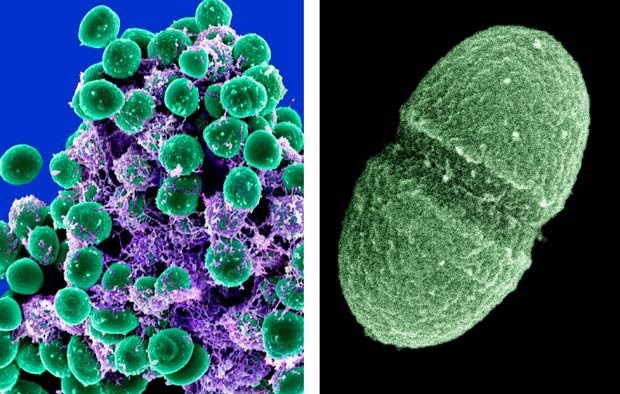Colegas,
como já devem saber, foi divulgado nas últimas semanas a evolução do Projeto Microbioma Humano, uma iniciativa enorme, que contou com dezenas de grupos de pesquisas distintos, sendo o centro de tudo o NIH (Aqui).
Copiei abaixo as publicações decorrentes do projeto, para análise dos interessados. Além disso, há dois posts abaixo com cópias de comentários do The New York Times e Veja sobre o assunto, que pode ser um dos mais impactantes para a história das ciências biomédicas.
Gastei um bom tempo pensando nestes dados... cheguei a algumas inflexões:
- Tenho a percepção de que já dispúnhamos destas informações, contudo os dados não estavam sistematizados, não havia homogeneidade experimental;
- Agora chega a hora da análise.... haja trabalho! Observamos resultados mais aplicáveis (palpáveis) dos diversos Projetos Genoma só agora!
- E a Imunologia, como fica nisso? Tenho certeza que Janeway (juntamente com os laureados no último Nobel) tinham uma boa noção na época que 'dividíamos espaço' com outros organismos, mas apostaria uma boa grana de que eles não previam a proporção desse contato...
- Na minha opinião, estes dados reforçam - de forma muito incisiva - o importante papel dos receptores de reconhecimento padrão (PRRs). Pelo visto, estas moléculas trabalham mais do que imaginamos....
E vocês, o que acham sobre o assunto?
________________________________________________________________________
Trabalhos Científicos Publicados:
Fonte: Welcome to the Data Analysis and Coordination Center (DACC) for the National Institutes of Health (NIH) Common Fund supported Human Microbiome Project (HMP)
http://www.hmpdacc.org/
NATURE | ARTICLE OPEN
Structure, function and diversity of the healthy human microbiome
NATURE | ARTICLE OPEN
A framework for human microbiome research
PLoS Collections: The Human Microbiome Project Collection (2012) www.ploscollections.org/hmp
Research Articles Top
Metabolic Reconstruction for Metagenomic Data and Its Application to the Human Microbiome
PLoS Computational Biology:Published 13 Jun 2012 | info:doi/10.1371/journal.pcbi.1002358
Diverse CRISPRs Evolving in Human Microbiomes
PLoS Genetics:Published 13 Jun 2012 | info:doi/10.1371/journal.pgen.1002441
Inflammatory Bowel Diseases Phenotype, C. difficile and NOD2 Genotype Are Associated with Shifts in Human Ileum Associated Microbial Composition
PLoS ONE:Published 13 Jun 2012 | info:doi/10.1371/journal.pone.0026284
Sequence Analysis of the Human Virome in Febrile and Afebrile Children
PLoS ONE:Published 13 Jun 2012 | info:doi/10.1371/journal.pone.0027735
Complex Carbohydrate Utilization by the Healthy Human Microbiome
PLoS ONE:Published 13 Jun 2012 | info:doi/10.1371/journal.pone.0028742
A Case Study for Large-Scale Human Microbiome Analysis Using JCVI’s Metagenomics Reports (METAREP)
PLoS ONE:Published 13 Jun 2012 | info:doi/10.1371/journal.pone.0029044
Host Genes Related to Paneth Cells and Xenobiotic Metabolism Are Associated with Shifts in Human Ileum-Associated Microbial Composition
PLoS ONE:Published 13 Jun 2012 | info:doi/10.1371/journal.pone.0030044
Analyses of the Microbial Diversity across the Human Microbiome
PLoS ONE:Published 13 Jun 2012 | info:doi/10.1371/journal.pone.0032118
A Core Human Microbiome as Viewed through 16S rRNA Sequence Clusters
PLoS ONE:Published 13 Jun 2012 | info:doi/10.1371/journal.pone.0034242
Novel Bacterial Taxa in the Human Microbiome
PLoS ONE:Published 13 Jun 2012 | info:doi/10.1371/journal.pone.0035294
Optimizing Read Mapping to Reference Genomes to Determine Composition and Species Prevalence in Microbial Communities
PLoS ONE:Published 13 Jun 2012 | info:doi/10.1371/journal.pone.0036427
A Metagenomic Approach to Characterization of the Vaginal Microbiome Signature in Pregnancy
PLoS ONE:Published 13 Jun 2012 | info:doi/10.1371/journal.pone.0036466
Evaluation of 16S rDNA-Based Community Profiling for Human Microbiome Research
PLoS ONE:Published 13 Jun 2012 | info:doi/10.1371/journal.pone.0039315
Reducing the Effects of PCR Amplification and Sequencing Artifacts on 16S rRNA-Based Studies
PLoS ONE:Published 14 Dec 2011 | info:doi/10.1371/journal.pone.0027310





Nenhum comentário:
Postar um comentário